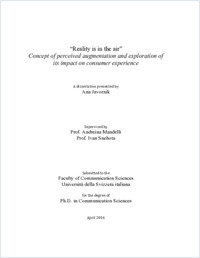“Reality is in the air” : concept of perceived augmentation and exploration of its impact on consumer experience
- Javornik, Ana
- Mandelli, Andreina (Degree supervisor)
- Snehota, Ivan (Degree committee member)
-
20.06.2016
210 p.
Thèse de doctorat: Università della Svizzera italiana, 2016 (jury note: Magna cum laude)
Augmented Reality (AR)
media characteristic
augmentation
attitude
flow
purchase intentions
consumer experience
vrtual try-on
retail
scale development
English
Augmented reality (AR) technology is becoming increasingly used in marketing as a tool for enhancing consumer experience. Developed and defined in the fields of computer science and human-computer interaction, AR technology simulates an overlay of virtual annotations in the physical environment and interacts with it in real- time (Azuma et al., 2001). Some popular examples of AR include virtual mirrors (Ray Ban, ModiFace) and smartphone applications that simulate products such as furniture (IKEA). Despite its increasing deployment in marketing, related academic research about the significance of AR for consumer experience and its impact on consumer behavior has been scarce. This thesis approaches this gap in the literature by studying media characteristics of AR and examining their impact on consumer affective, cognitive and behavioral responses, following the approach of Theory of Interactive Media Effects by Sundar et al. (2015). Throughout a series of four articles, it aims to define salient media characteristics of AR technology and evaluate how they alter consumer experience. The 1st article examines to which extent AR shares media characteristics of other interactive technologies and how these characteristics – namely interactivity, modality, hypertextuality, connectivity, location-specificity, mobility, virtuality – influence consumer responses. Based on a literature review, a research agenda is proposed that identifies the knowledge gaps related to the impact of AR on various types of consumer responses. For example, it suggests that future research should investigate: how lower levels of hypertextuality in an AR app influence consumer satisfaction and exploratory behavior; how can AR represent a social experience, given that little connectivity is present in the current AR apps; what combinations of modality in terms of text, visuals and audio are most effective for AR; to which extent consumers perceive AR apps to be interactive and how that impacts their experience. Finally, the research agenda also underlines the importance of investigating the AR media characteristic augmentation (Preece et al., 2015), absent in previous interactive technologies. The 2nd article focuses on two salient media characteristics of AR apps – interactivity and augmentation. It shows that the presence of AR does not translate into an app being perceived as more interactive in comparison to a non-AR app in terms of control and responsiveness. On the other hand, the study offers first evidence that perceived augmentation is significantly higher for AR apps than for non-AR apps and that it represents a suitable psychological correlate (Sundar et al., 2015) for measuring the perception of AR characteristics that set it apart from other technologies. Two experimental studies demonstrate that perceived augmentation impacts the level of immersion into flow, which then mediates the impact of perceived augmentation on consumer attitude towards the app and behavioral intentions to use it again and talk about it. Based on the previous study, the 3rd article further develops the measurement items of perceived augmentation and investigates its impact on consumer experience. An in-the-wild study (Rogers, 2012) was conducted in a retail store, where we observed consumers’ interaction with an AR make-up try-on application. The findings show that such an application creates a playful experience and that shoppers would use such tool to narrow their consideration set or, in some cases, to even choose products to purchase. Furthermore, the survey study confirms that perceived augmentation significantly relates with playfulness, perceived convenience and behavioral intentions. Finally, a more complete scale for perceived augmentation is developed and validated in the 4th article. Items are refined through several qualitative studies, based on which we propose that perceived augmentation is comprised of two dimensions – virtual enhancement and virtual- physical congruency. An online study with 213 participants confirms this dimensionality and, furthermore, shows that virtual-physical congruency elicits significant impact on enjoyment and perceived informedness, which further impacts future use and purchase intention, while virtual enhancement does not yield a similar impact. The contribution of this thesis lies in defining perceived augmentation as the psychological correlate of AR’s unique media characteristic, augmentation, and in proposing and validating its measurement items. Furthermore, a series of three larger studies, all situated in different contexts (in a lab, in a retail store, online), explain how perceived augmentation yields a significant impact on consumer affective responses and behavioral intentions, and in some cases also on cognitive responses such as perceived convenience and informedness. It also highlights the importance of AR app integration in a specific context, which can prevent it from being perceived as gimmicky. The results of this work have implications for both practitioners and academics and offer numerous directions for future research.
- Language
-
- English
- Classification
- Information, communication and media sciences
- License
-
License undefined
- Identifiers
-
- RERO DOC 261144
- URN urn:nbn:ch:rero-006-115271
- ARK ark:/12658/srd1318579
- Persistent URL
- https://n2t.net/ark:/12658/srd1318579
Statistics
Document views: 442
File downloads:
- Texte intégral: 391
